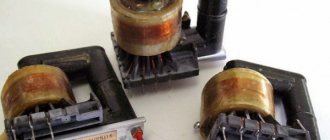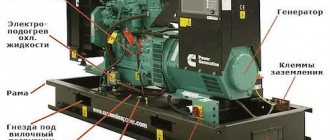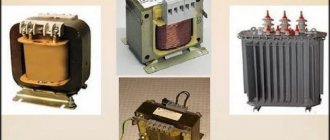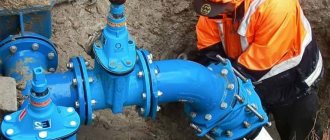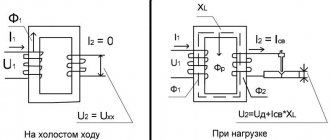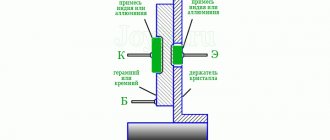Operating principle of a concrete pump
The pace of construction in the mid-20th century led to the formation of new cities, new technologies for constructing high-rise buildings, and a completely different outlook on the construction industry. Concrete is one of the main building materials used in building construction, and concrete pumping technology is recognized as an effective tool for optimizing the work process. How a concrete pump works, the main functions and tasks of special equipment at a construction site, let’s try to understand in detail the basic data of special concrete pump equipment.
Appearance of the concrete pump
General concepts of special equipment
At its core, the concrete pump device is designed for the rational supply of concrete mixture to a construction site. To produce concrete material, special bunkers are used that produce concrete of the appropriate grade. Considering that concrete has specific hardening characteristics, concrete pumping equipment is used to ensure that the mass retains its characteristics. For efficient operation of the equipment, the concrete pump circuit takes into account the continuous cycle of supplying the solution to the object, where it is possible to achieve the effectiveness of the material according to the primary parameters.
According to its technical parameters, the equipment can be divided into two groups, and, by the way, by watching the story on the Internet, you can find out how a concrete pump works in a good quality video.
- Mobile type. In this capacity, a vehicle is used, on the chassis of which the concrete pumping part of the installation is installed.
Mobile concrete pump
- Stationary type. A trailed version of special equipment, which is also equipped with a concrete pumping kit.
Stationary concrete pump
The operating principle of each type of concrete pump lies in its power characteristics.
The stationary option is very attractive for the construction site, due to the presence of a basic supply kit and concrete extrusion systems.
The mobile type is inferior in some characteristics, but is ideal for the local option of pouring concrete, where the main concrete pipeline is able to organize the supply of material in a hard-to-reach place.
In addition, you will notice, having learned how a car concrete pump works, that for this type of equipment there is no need to involve complex technical solutions for connecting and putting into operation the main and auxiliary set of pumping equipment.
“There is one significant drawback for a stationary concrete pump; it is the presence of a long hose for supplying the solution, which is impractical to use for the local type of pouring the material.”
Let's try to find out how a stationary concrete pump works by studying the configuration options for special equipment:
- Piston system. In this case, the injection of a mass of concrete mixture is carried out using a built-in piston group.
- Hose or pistonless type. Here, liquid is pumped using a built-in roller system.
Piston group of concrete pumps
In order for us to answer the question posed about how a concrete pump works, let’s take as an example the piston group of special equipment. In Russia, the CIS countries, as well as in most countries of the world, the piston version of special equipment is recognized as rational and effective for a number of reasons. The operating principle of a piston concrete pump provides for portioned supply of solution from the bunker reservoir to the concrete supply system.
The presence of a hydraulic drive system ensures the supply of material in a smooth mode, without visible sudden jumps and drops. Installation of a hydraulic pump on the unit allows for increased performance of the pump itself, which in turn ensures efficient processing of the supplied concrete mixture.
Another advantage is the fact that hydraulics allow the solution to be supplied to an acceptable height on the construction site.
Operating principle of a rotary concrete pump
This type of special equipment is rarely used, but for some technological techniques on a construction site this option will be a rational solution. Unlike the piston group, the material is supplied not into the hopper chamber, but directly into the rubber hose. On the outside of the concrete hose pipe there are rollers that are involved in the process of supplying the material, thereby ensuring the pushing of the substance to the exit.
Overall dimensions of a standard concrete pump
Overall dimensions of the concrete pump
How to choose the right category of special equipment?
Now you know how a concrete pump works, how special equipment is selected for carrying out technological construction operations. The rotor design allows the use of material with coarse filler, while the feeding process ensures uniform pushing of the substance through the concrete pipeline. There is an additional advantage of this system: when washing, the rotor part of the special equipment is easily treated with ordinary artesian water, that is, it is easier to clean in preparation for additional work.
In addition to positive factors, there are disadvantages to both the rotary system and the piston group of special equipment. For piston-type special equipment, wear characteristics are very common due to the ingress of concrete milk and other aggressive products into the main mechanism of the piston group.
For some production operations, the piston mechanism is not capable of providing portioned supply of material to the production facility, that is, there is no proper effect from portioned supply of material. The rotary version effectively copes with the task of portioned supply of the mixture to the object. At the same time, the obvious disadvantage of the rotary version is its very low productivity, which is unacceptable for large volumes of construction.
Rapid wear of the main supply element - the hose of the rotor system very often fails, which creates additional inconvenience in work, requiring frequent replacement and washing of the concrete pipeline.
More information about concrete pumping technology
To extend the service life of a concrete pump, technologists use a special concrete mix loading map for a certain type of specialized equipment. Large crushed stone and foreign particles are a problem with the quality of the concrete mixture, and, therefore, this affects the operation of the equipment as a whole. For the rotary type of concrete pump, a concrete mixture with small fractions of crushed stone is used, and for the piston group, higher fractions of crushed stone material are used.
In order for the concrete mixture not to lose its characteristics, it is necessary to calculate the volume of the material mass for 15-20 minutes of work, so that a new portion can be prepared for loading into concrete pumping equipment. When loading concrete material, the time interval must be strictly observed to ensure the quality of the concrete mixture for the production cycle.
: operating principle of concrete pump
Marina
September 21, 2017
articles:
Source: https://ospetstehniki.ru/articles/printsip-rabotyi-betononasosa.html
Principle of operation
A concrete pump is a special device and is designed to supply concrete mixtures to the place of their laying through pipelines or concrete pipelines intended for this purpose during the construction of various buildings and various structures made of solid monolith or reinforced concrete. The work is based on the usual principle of displacement and consists in creating a changing volume in the system. If the volume is completely filled with concrete mixture, and then decreases somewhat, then it is forced out into a special concrete pipe.
Based on the principle of operation, they are divided into piston ones, which have a periodic supply, as well as hose ones, which are characterized by a continuous supply of the mixture. According to the principle of their operation, they can be standard, trailed, mobile, or they can be concrete pumps. Their drive can be hydraulic or mechanical. The most basic parameters of such construction equipment are feed height, distance and productivity.
Piston group of concrete pumps
In order for us to answer the question posed about how a concrete pump works, let’s take as an example the piston group of special equipment. In Russia, the CIS countries, as well as in most countries of the world, the piston version of special equipment is recognized as rational and effective for a number of reasons. The operating principle of a piston concrete pump provides for portioned supply of solution from the bunker reservoir to the concrete supply system. The presence of a hydraulic drive system ensures the supply of material in a smooth mode, without visible sudden jumps and drops. Installation of a hydraulic pump on the unit allows for increased performance of the pump itself, which in turn ensures efficient processing of the supplied concrete mixture. Another advantage is the fact that hydraulics allow the solution to be supplied to an acceptable height on the construction site.
How a concrete pump works: features of piston and rotary systems, options for basing units
The modern construction industry market uses a wide range of structural and auxiliary materials. But for hundreds of years, concrete has remained the unchanged leader. With the advent of this unique material, the price and speed of building construction have decreased significantly.
In the old days, a serious problem was the rapid delivery of the mixture directly to the pouring site; old masters were forced to carry concrete in buckets with their own hands. But scientific and technological progress, fortunately, does not stand still and now this problem is successfully solved with the help of various types of concrete pumps.
Photo of an industrial automobile concrete pump.
Unit types
The entire range of concrete pumps on the market can be divided into 2 types: mechanical and hydraulic. The design can be based on the use of a piston principle or without a piston.
Transfer of solution.
Operation of the piston system
The general principle of operation of piston systems is far from new; a significant part of all existing mechanisms are based on it. In this case, the piston, when moving backward, sucks in a certain amount of the mixture from the concrete receiver and then pushes it directly into the transfer hose, through which it flows to the pouring site.
The operation of this system would not be possible without the use of a slide gate or curtains. The gate valve opens the concrete receiver during suction and closes when expelling. Thereby transferring the direction of movement of the mixture from the concrete receiver to its destination.
Piston units can operate either mechanically or using a hydraulic system. Currently, the vast majority of devices use a hydraulic system. Hydraulics provide significantly higher pressure, resulting in significantly increased pump power.
Piston system with 1 cylinder.
Unlike the connecting rod mechanism, hydraulics have a much longer stroke of the working piston. Plus the piston movement becomes smoother. The sore spot of these pumps is the tightness of contact between the piston and the chamber walls. Microparticles of cement mortar inevitably get between the piston and cylinder, significantly increasing the wear of parts.
Single-cylinder units are now rarely used due to the unstable, pulsating supply of solution. The system, equipped with two alternating cylinders, ensures a stable, uninterrupted supply of the composition and wears out much less.
Important: hydraulics can operate on water or oil. In the first case, the pressure will be about 5 MPa, in the second exactly 2 times more.
Plus the oil system is more durable and reliable.
Diagram of a piston concrete pump with 2 cylinders.
Rotor system operation
The family of piston-free structures is somewhat broader; the most famous here is the rotary concrete pump. The basis of the system is a rotor on which rubberized rollers are attached.
When the rotor rotates, the rollers move the concrete solution from the concrete receiver in the desired direction. They are convenient because reverse can easily remove congestion and air pockets.
The rotor system most often fails due to wear of the reinforced hose and rubber seals. The power of such units, compared to piston ones, is small, plus they do not tolerate solutions with large fillers such as crushed stone for concrete products.
A concrete screw pump is a type of rotary pump without a piston. The principle of operation of the auger was described in detail by Archimedes. But, despite its advanced age, it is still widely used in various mechanisms.
Set of connecting sleeves.
The instructions here are simple: a screw auger is placed in the through chamber and rotation ensures the movement of the substance. An ordinary household meat grinder can serve as a visual illustration that has been known since childhood.
Unit mounting options
This type of mechanism is presented in a wide range on the market; according to the method of installation, they are divided into stationary and automotive.
Supply of solution to height.
Stationary pumps
The stationary compact concrete pump is a separate independent station for pumping solution. Depending on the size and power, it can be used both at large industrial facilities and in private construction. It can be based on or without a chassis.
A mobile concrete pump that does not have a chassis, as a rule, has high power and is installed to supply a large object, most often high-rise buildings, with mortar. The presence of a chassis also does not provide for transportation over significant distances. Chassis are needed for ease of movement within one object.
Stationary unit on a single-axle chassis.
Important: a trailed concrete pump is currently being produced; structurally, it is classified as stationary. But the presence of a powerful automobile chassis makes it possible to move over considerable distances using a tractor.
To meet the needs of private construction, a stationary piston mini-concrete pump is produced. It is used for working in cramped conditions and small volumes. In addition to the piston system, the small-sized concrete pump can be operated by a pneumatic drive.
The pneumatic concrete pump has been developed relatively recently and is more intended for pumping homogeneous cellular types of concrete. It does not have much power, plus for stable operation it requires a compressor, which is not always feasible under construction conditions.
Trailer unit diagram.
Pumps on a car base
An automobile concrete pump is now the most common option in both private and industrial construction.
Compared to competitors:
Diagram of a concrete pump.
- A powerful stationary installation is only good for large volumes; it is clumsy and expensive to maintain . A concrete pump truck can reach most sites.
- Most of the stationary units require power supply, which is not always possible in construction conditions . An automobile concrete pump is integral with the machine and is powered by its power plant.
- A small-sized concrete pump at a large construction site cannot cope with the volume . As for private construction, not every owner can afford the price of such a unit. It is much cheaper to order a concrete pump and use it to pour the required volume of concrete within a few hours. The rental price will be noticeably lower than the purchase of a stationary unit.
- In addition, modern complexes are equipped with a retractable boom for easy delivery of the solution to heights or to objects of complex configuration . If using a boom is not possible, there is an automobile linear concrete pump. With its help, you can pump the solution through pipes over a distance of up to 1 km horizontally and up to 120 m vertically.
- Another important advantage of the automobile version is that it is serviced by a professional operator..
Using a folding boom.
How realistic is it to make the unit yourself?
The simplest option is to make a piston pump with one cylinder. Initially, it is advisable to understand the drawings. You will also need access to a lathe to make the piston and cylinder. Plus add the purchase of a motor, gearbox and gate valve.
Design features and types of gasoline pumps
The stationary concrete pump is equipped as standard with a diesel engine, which includes an automatic speed controller and a pre-heating system, which greatly facilitates starting the engine in the cold season. The most popular today are two-piston models, during the operation of which a reciprocating movement of piston systems is performed to pump the solution.
stationary concrete pump Putzmeister in monolithic construction
Also on site you can often find a diaphragm pump, the operation of which is based on the use of a rubber diaphragm. Due to its movement, the internal volume of the working chamber changes. The only problematic point in using this category of special equipment may be that these automobile concrete pumps should not work with mixtures that contain large inclusions due to the rapid wear of the membrane. In this regard, all working solutions must be filtered through a special sieve.
In addition, electric concrete pumps can be used, as well as individual models designed specifically for the most intense operating conditions. When pumping mixtures over short distances, hose or perilstatic units are mainly used, which have the advantage of being able to work without interruption.
The technical characteristics of concrete pumps of this type allow them to lift the solution to a height of up to 30 m . They become the optimal solution when working with thin solutions, as well as mixtures with gravel filler. Among the special advantages of this design, it is worth noting the rather simple design of the mechanism and minimal energy consumption during operation.
Standard concrete pump design
The main structural elements of an automobile or stationary concrete pump are
- receiving bunker,
- concrete pipeline,
- double-acting hydraulic drive,
- cylinders.
The cylinders of the unit are driven by a hydraulic cylinder system. The entire structure is mounted on a reliable and durable housing frame assembled on a mobile chassis.
Thanks to the presence of a powerful drive, special equipment manages to maintain fairly high pressure levels inside the system (70-240 bar). This parameter can be quickly adjusted by adjusting the amplitude of movement of the pistons. At the same time, high-class special equipment is characterized by a fairly smooth ride and good adjustment. As a result, manufacturers are able to significantly reduce the wear rate of parts of stationary or automobile concrete trucks.
truck-mounted concrete pumps with delivery heights up to 65 m
Despite the fact that, regardless of the mobility of the equipment, each of the models has wheels for transportation, with the difference that stationary models only allow them to be moved around the construction site, they are transported over long distances by freight transport. In order to ensure complete immobility of the unit during its operation, special stoppers are used to secure the equipment. Most brands of special equipment are characterized by a focus on the highest possible technical characteristics of concrete pumps , which will allow the equipment to work with almost any mixture.
Concrete pumps
Concrete pumps belong to special construction equipment and are necessary for supplying concrete to hard-to-reach places when the access of concrete mixer trucks is difficult. The concrete pump can supply concrete solutions not only horizontally, but also vertically. The maximum boom size of a concrete pump is 64 meters and it belongs to industrial special equipment. The cost of these pumps is several tens of millions of rubles; accordingly, the rental price per shift is also high.
But what if trains need to be delivered over a longer distance? There is a solution!
Truck-mounted concrete pumps - application in construction
For such purposes, linear concrete pumps are used; the principle of operation is to connect an additional line to the boom or hopper, consisting of 3-meter pipes secured with clamps. The pumping length using this type of concrete pump can vary up to 200 m. Installation, dismantling and washing of concrete pipelines is carried out by the customer.
There is usually up to 80 meters of concrete pipe on board, and if a larger quantity is required, it is necessary to order additional transport, which, as you understand, will increase the rental cost.
When operating the autopump, a centralized supply must be organized to avoid the solutions setting inside the line, which can lead to its damage.
Operating conditions of a concrete pump
When ordering concrete pumps, you need to properly prepare the site. Depending on the length of the ABN boom, the dimensions of this platform also change. On average, for propulsion pumps the site dimensions are 6 x 9 meters.
Moreover, for the linear ABN type, the starting chemical additive that is included in the price tag of a conventional pump is no longer enough.
After installing the pump and laying out the line, the person responsible for accepting concrete products needs to purchase cement laitance from the manufacturer, or purchase two bags of cement, which are usually enough to get started. The operator will coordinate the foreman regarding the necessary actions.
Design and principle of operation of a concrete pump
The purpose of the concrete pump is to supply the solution to the laying object through a special pipeline or through branches if laying is planned in a continuous flow. This technology is relevant for the construction of residential buildings and industrial buildings, since the mixture is prone to rapid solidification and requires constant maintenance of its original state. The design of the concrete pump allows you to carry out the necessary processes that guarantee the safety of the technical characteristics of concrete and its quality indicators as a building material.
Concrete pump device
There are several current types of concrete pumps, differing in their operating principle. The differences between them lie in the type of functioning and technical structure. The required installation is selected by specialists for each specific project.
- Piston concrete pumps involve the operation of a cylinder and a piston. They have a cylinder to move the piston, which sucks up the concrete and directs it into the hopper. The flow is controlled by valves.
- Rotary concrete pumps demonstrate low productivity and delivery range of the solution due to the peristaltic technology of the influence on the composition. The principle of operation of a concrete pump is as follows: it looks like an elastic hose that is subjected to rolling rollers that press the solution and advance it in order to increase pressure.
- Screw concrete pumps are quite compact and are a screw shaft with a function similar to an auger. The shaft consists of several screws, and the holder, directed along the axis, is a cavity for them. Closed cavities are filled with solution as the shaft rotates along the axis. The operating principle of concrete pumps of this format excludes the possibility of the presence of large solid particles in the mixture, the diameter of which is more than 6 millimeters.
- Pneumatic blowers operate by supplying air into a hermetically sealed chamber under the influence of pressure, which splashes out the solution. With its help, you can simultaneously prepare a concrete mixture by loading all the components of the mixture into the bunker.
- The diaphragm device works due to the fact that the compressed walls act on the mixture entering the chamber, thereby closing the inlet valve and opening the outgoing valve.
All types of concrete pumps are relevant in modern construction and the choice when renting is made based on the characteristics of their functioning and the principle of supplying concrete solution to the treated area. Each device can be used both in the construction of residential buildings and in industrial construction.
Operating principle of a concrete pump
The operation of a concrete pump is due to the displacement of liquid. Depending on the principle of operation, devices can be classified into piston and hose, the difference between which will be the frequency of supply of the mixture. Experts distinguish the following types of concrete pumps:
- Typical (or standard)
- Mobile;
- Trailed;
- Truck-mounted concrete pumps.
Any model can have a hydraulic or mechanical drive, and the main indicators of equipment optionality are the height and delivery distance, as well as productivity.
The design and operating principle of each type of concrete pump differs from the alternatives. The most commonly used option is the piston type, which turns out to be much more economical and demonstrates high performance.
It is easy to operate and does not require specific maintenance, both during and after operation. The design of a piston concrete pump is such that it has limitations on the range of concrete distribution and is not characterized by mobility.
The pressure when supplying the solution, as well as the cost of the device, directly depends on the diameter of the pipes. This is why the popularity of concrete pipes has increased so much.
How does a concrete pump work?
The operating schemes for each type of concrete pump are slightly different, but there is a traditional one (Fig. 1).
Installing a concrete pump on any platform will not help add mobility, since it can thus only be moved across one area. In this case, the best option would be a truck-mounted concrete pump for supplying concrete, which is installed on a chassis. There are several more of them than the standard type of car of this version. Thanks to the mobility of this design, as well as the constant supply of concrete mixture, the concrete pump becomes more advanced.
The main feature of this pump is the presence of a special boom that can be folded out. It consists of fixed knees. Control, more precisely, lifting and turning, allows you to put the structure in the desired position in which the concrete solution is poured. For concrete conveyors, there are booms of various lengths, which allows for maneuverability and ease of operation.
